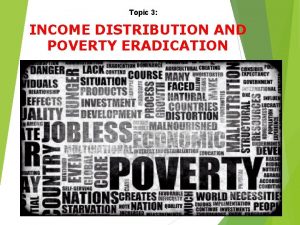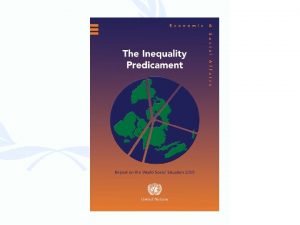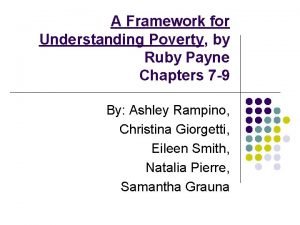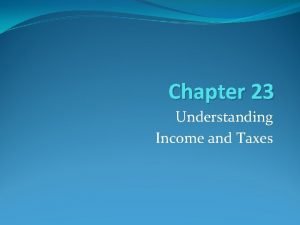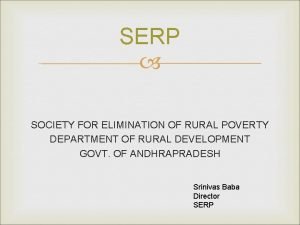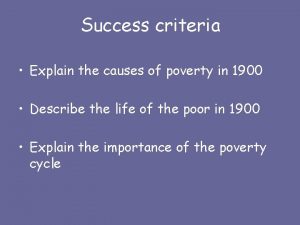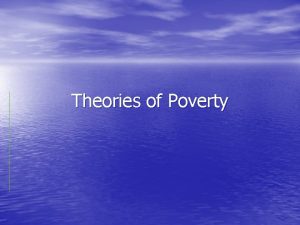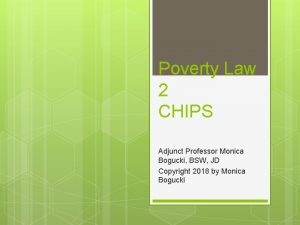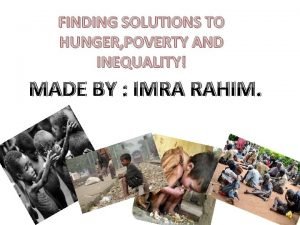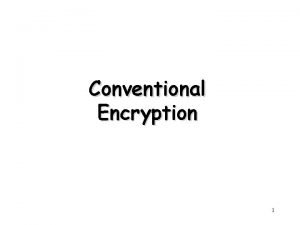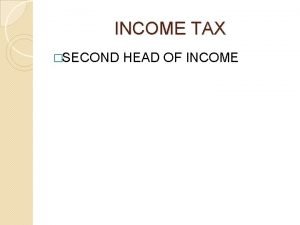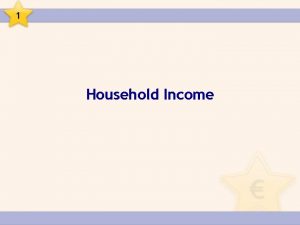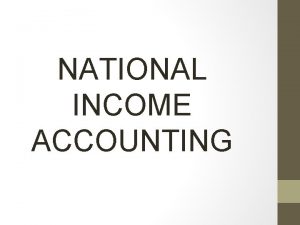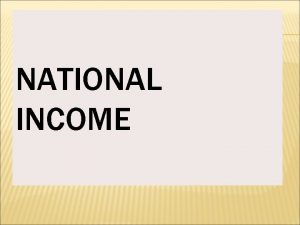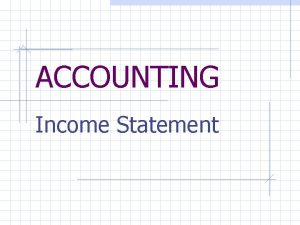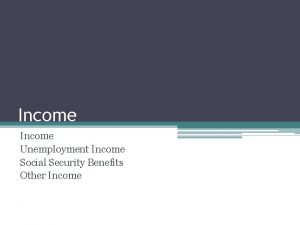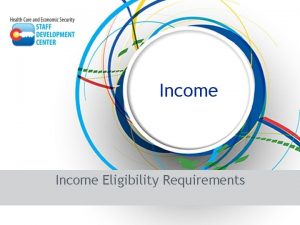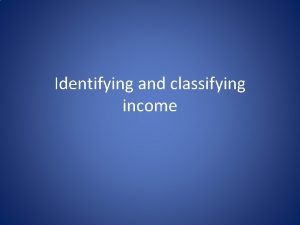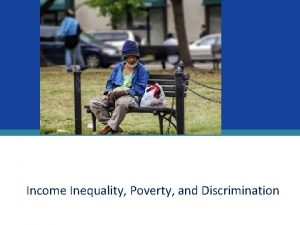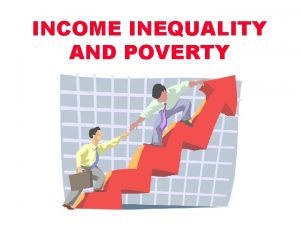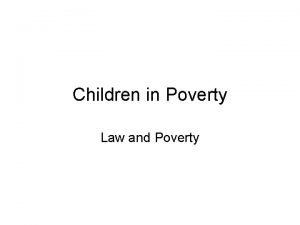Poverty 1 Conventional economic understanding income poverty 2

















- Slides: 17

Poverty 1. Conventional economic understanding ” income poverty” 2. Poverty includes income, ignorance, ill health, disempowerment, gender issues and vulnerability.

Poverty • What the Poor Say : “Poverty is pain; it feels like a disease. It attacks a person not only materially but also morally. It eats away one’s dignity and drives one into total despair”- a poor woman, Moldova. Voices of the poor - World Bank http: //siteresources. worldbank. org/INTPOVERTY/Resources/poor. pdf

Poverty • Poverty is associated with the undermining of a range of key human attributes, including health. • The poor are exposed to greater personal and environmental health risks, are less well nourished, have less information and are less able to access health care; they thus have a higher risk of illness and disability. • Conversely, illness can reduce household savings, lower learning ability, reduce productivity, and lead to a diminished quality of life, thereby perpetuating or even increasing poverty.

Poverty • Poverty is often defined in absolute terms of low income…but in reality, the consequences of poverty exist on a relative scale. • The poorest of the poor, around the world, have the worst health. Within countries, the evidence shows that in general the lower an individual’s socioeconomic position the worse their health. • There is a social gradient in health that runs from top to bottom of the socioeconomic spectrum. This is a global phenomenon, seen in low, middle and high income countries.

How are all countries, rich and poor, define poverty? Absolute poverty lines (option 1) • Including the recently updated World Bank global poverty line of US$1. 90/day, . • Are widely used by developing countries, since large portions of their populations count on a limited number of goods to meet their basic needs. • Middle and high income countries may also chose to adopt absolute poverty lines – as is the case of the United States. These, however, need to be ‘socially relevant’, where it is commonly understood that their calculation (on the basis of a bundle of food and non-food goods) represents the absolute minimum below which livelihood and inclusion are not possible in that particular country and social context.

Relative poverty lines (option 2) • As income level rises, countries may opt to use relative poverty lines (option 2). Relative poverty lines are defined in relation to the overall distribution of income in a country – they are set as a share (usually between 40 and 60 percent) of the country’s mean income. As such, they are more suitable to measure poverty in middle and high income countries. • In prosperous societies, poverty is generally assessed vis-à-vis the standard of living of society as a whole, whereby people are considered poor relative to the wealth of others and if they cannot meaningfully participate in that society because of lack of resources. Relative poverty lines implicitly assume that the cost of social inclusion increases proportionally with the income of society. A number of countries, particularly in Europe, have adopted relative poverty lines.

Subjective poverty line • A third option available to countries is the subjective poverty line, which is set on the basis of what people perceive as the minimum income (or consumption) that a person, or household, needs in a specific society to not be considered poor. Subjective poverty lines come from perception surveys and are not widely used.

Why did the World Bank decide to update the International Poverty Line, • and why now? • As differences in the cost of living across the world evolve, the global poverty line has to be periodically updated to reflect these changes. • Since 2008, the last update, was $1. 25 as the global line. • As of October 2015, the new global line will be updated to $1. 90.

• What does this mean for previous estimates? We have back-casted the estimates for previous years, in order to assess the trends in poverty reduction over the last 25 years. These trends continue to show that the world has made impressive progress in reducing poverty since 1990, but that poverty persists at unacceptable levels, and much more needs to be done to ensure that people continue to move out of poverty in the years to come.

What does this mean for previous estimates? We have back-casted the estimates for previous years, in order to assess the trends in poverty reduction over the last 25 years. These trends continue to show that the world has made impressive progress in reducing poverty since 1990, but that poverty persists at unacceptable levels, and much more needs to be done to ensure that people continue to move out of poverty in the years to come.

• What is the new poverty line, and based on this new measure, how many people are living in extreme poverty in the world? The new global poverty line is set at $1. 90 using 2011 prices. Just over 900 million people globally lived under this line in 2012 (based on the latest available data), and it is estimated that in 2015, just over 700 million are living in extreme poverty.

Why raise the poverty line? What was wrong with the $1. 25 a day line that we are all used to? • As differences in the cost of living across the world evolve, the global poverty line has to be periodically updated to reflect these changes. • The new global poverty line uses updated price data to paint a more accurate picture of the costs of basic food, clothing, and shelter needs around the world. In other words, the real value of $1. 90 in today’s prices is the same as $1. 25 was in 2005.

Should I use this new poverty line to plan programs and policies in my country? • It is important to note, however, that the global poverty line is used primarily to track global extreme poverty, and to measure progress on global goals set by the World Bank, the United Nations, and other development partners. A country’s national poverty line is far more appropriate for underpinning policy dialogue or targeting programs to reach the poorest.

• Should I use this new global poverty line to plan programs and policies in my country? While the global extreme poverty rate may not be dramatically different after the adoption of the new PPP and poverty line, some regional and country rates may fluctuate considerably. • It is important to note, however, that the global poverty line is used primarily to track global extreme poverty, and to measure progress on global goals set by the World Bank, the United Nations, and other development partners. A country’s national poverty line is far more appropriate for underpinning policy dialogue or targeting programs to reach the poorest. For example, in a middle-income country, where the national poverty line is at $4 a day, the global poverty threshold may be less relevant than in a poorer country where the national line is at $1. 65 or similar.

Doesn’t this put too much emphasis on money? What about the other dimensions of poverty? • There are many non-monetary indicators—on education, health, sanitation, water, electricity, etc— that are extremely important for understanding the many dimensions of poverty that people experience. These are an important complement to monetary measures of poverty and are crucial to effectively improving the lives of the poorest. • The global poverty line does not currently take these multiple dimensions of poverty into account. • There is a recently-established Commission on Global Poverty who is currently assessing how to measure and understand poverty.

To end extreme poverty by 2030 Countries need to make deliberate policy decisions that make growth more inclusive; that prioritize investments in education, health, clean water, sanitation, and smart infrastructure that benefit the poorest; and that help people protect their hard-won gains and assets to avoid falling right back into poverty after a drought, disease, or economic shock.

We can end extreme poverty by 2030 by: Investing in agriculture Creating jobs Expanding social safety nets Expanding nutrition programs that target children under 2 years of age • Universalizing education • Promoting gender equality • Protecting vulnerable countries during crises • •
 Relative poverty
Relative poverty Low income poverty
Low income poverty Low income poverty
Low income poverty Ruby payne framework for understanding poverty
Ruby payne framework for understanding poverty Ruby k payne a framework for understanding poverty
Ruby k payne a framework for understanding poverty Partnership income statement format
Partnership income statement format Chapter 16 accounting for income taxes
Chapter 16 accounting for income taxes National income accounting
National income accounting Tax liability definition
Tax liability definition Chapter 23 understanding income and taxes
Chapter 23 understanding income and taxes Prof. meier and baldwin
Prof. meier and baldwin Lesson 2 our economic choices
Lesson 2 our economic choices Economic growth vs economic development
Economic growth vs economic development Www serp ap gov in mobile bookkeeping
Www serp ap gov in mobile bookkeeping The causes of poverty
The causes of poverty Oscar lewis theory
Oscar lewis theory Adjunct poverty definition
Adjunct poverty definition Poverty and hunger solutions
Poverty and hunger solutions
